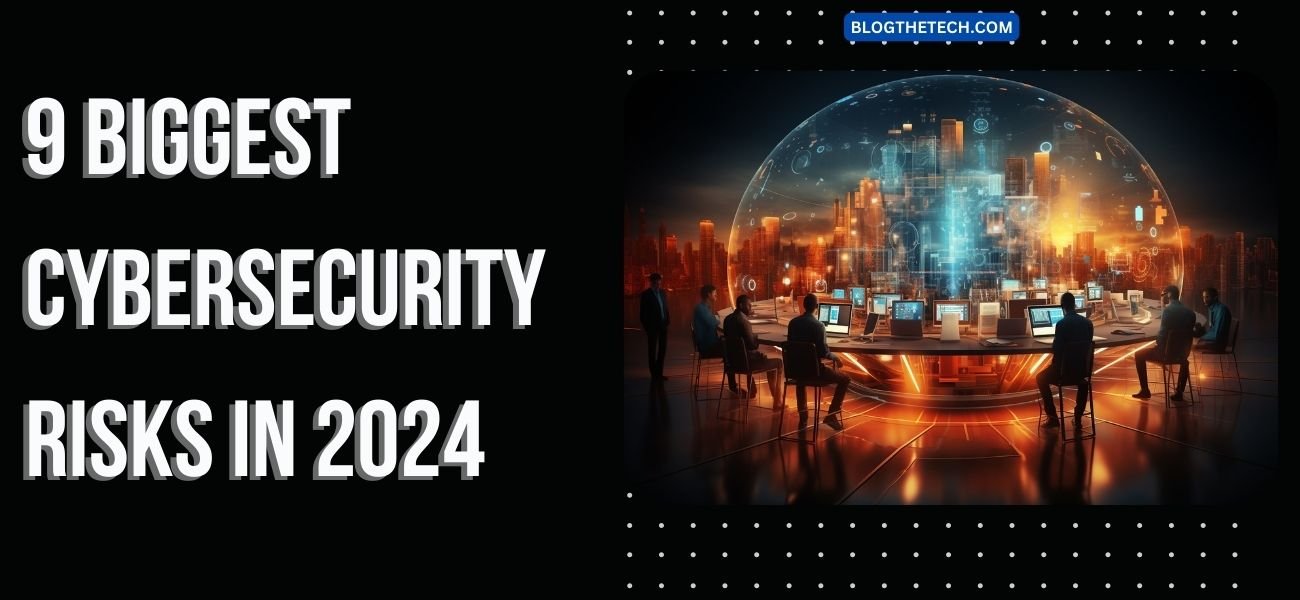Cybersecurity threats are becoming increasingly complex and intertwined in our everyday lives because of technology. 2024 presents advanced technologies that bring about new challenges to cyber security. People as well as companies have to understand the potential threats they might face in this digital age.
The cyber world is always evolving; hence, so are the dangers it presents us with. It is not just about preventing data breaches but also deals with other issues, among them phishing, which happens on a daily basis to any person using the internet. A good vulnerability management tool can prevent these forms of cybercrime.
9 Biggest Cybersecurity Risks In 2024

The article will highlight the top nine cybersecurity risks in 2024 and why they stand out more than ever before. Here are some examples:
1. Phishing
In 2024, phishing will become more insidious. There are now advanced ways in which cybercriminals conduct phishing, such as spear phishing directed at individuals or organizations or whaling, which mainly targets high-level officials like executives. These emails will often appear authentic, making them hard to separate from genuine communication, although that is not always the case.
One other emerging trend is smishing (smishing refers to ‘phishing via SMS’ in recognition of increased reliance on mobiles for communication), even though it may be considered new since most people do not understand this term.
In order to fight against phishing, it is important to have a culture based on cybersecurity awareness. Significant strategies include regular training sessions on recognizing phishing attempts and the deployment of advanced email filtering solutions. Also, it is important for organizations to be cautious about any unsolicited emails or messages requesting important information.
2. Social Engineering
In 2024, social engineering will have advanced through the use of deepfake technology and personalized scams that work well under the current circumstances. Rather than focusing on technical vulnerabilities, the primary form of attack in social engineering usually follows human weaknesses, making it hard to stop.
The best defense against social engineering is education and training. Regular awareness programs can help individuals recognize and respond appropriately to social engineering tactics. In addition, implementing hard verifications for sensitive requests can prevent any successful ones.
3. Ransomware
Ransomware attacks in 2024 have become more severe, with attackers encrypting data while threatening to release it publicly (double extortion). They now tend to diversify by targeting large corporations as well as small businesses or government institutions, thus exploiting the outdated software loopholes.
Defensive measures involve maintaining backups regularly, updating systems as soon as they notify us about an update, and using strong endpoint security solutions, among others. Establishing a ransomware response plan may also involve isolating infected computers and communication steps during an attack. Besides investing in educating employees regarding possible ransomware threats,.
4. IoT Vulnerabilities
There has been an increase in the number of IoT devices being used over the past few years, making it possible for cybercriminals to launch more attacks when compared with other years. Most of these devices have no basic security measures, making them easy targets to compromise. They can be used for unauthorized access to networks or as part of larger-scale botnets.
Changing default passwords, regularly updating firmware, and segregating IoT devices into different network segments are ways to make them safe. Additionally, manufacturers need to focus on security while designing their products so they can provide regular security patches and updates.
5. Cloud Security
This year, 2024, is when cloud services are more popular than before; therefore, it comes with increased risks such as data breaches, insecure interfaces, and account hijacking. Providers need to collaborate with clients under the shared responsibility model if they plan on ensuring security in this field.
Key strategies for enhancing cloud security include:
• strong access controls
• data encryption while at rest or during transmission
•multi-factor authentication
It is also important that regular security audits are carried out so as to ensure compliance with the policies outlined in every business plan.
6. Insider Threats
Insider threats in 2024 involve both negligent and malicious insiders. These individuals are often in a position to cause significant harm due to their access to confidential information. Monitoring access has become more complicated because of the rise of the rise of remote work.
Technological and procedural solutions can be useful in curbing these threats. These measures include setting strict access controls, regular security training for employees, and user behavior analytics to detect any abnormal activities that may indicate a threat worth following up on.
7. AI and Machine Learning
AI and ML technologies will introduce new vulnerabilities in 2024, despite their benefits. These include artificial intelligence-fueled attacks capable of self-learning while adapting to defense strategies, among others. Furthermore, data pollution is possible if enemies provide the wrong information to machine learning algorithms.
Managing those risks demands securing datasets used for training AI models and monitoring AI systems against signs of tampering or anomalies. Apart from that, ethical principles as well as strong testing protocols for AI systems may mitigate some potential dangers posed by AIs.
8. Supply Chain Attacks
Multiple attacks have shown that a single weakness in the supply chain would ultimately jeopardize many organizations by 2024. They usually focus on the less secure parts of a supply chain, such as small retailers.
To avoid such attacks, it will be important for entities to ensure a comprehensive security assessment of their suppliers as well as implement stringent access controls. Also, an early detection and prevention mechanism would necessitate regular monitoring programs within the supply chain if anything suspicious occurs.
9. Mobile Security
The use of mobile devices that are versatile today has come with a significant undesirable trend because of mobile security; the major problem is that in 2024 it is still an issue. The threats may come in the form of app-based, unsecured Wi-Fi networks, among others.
- Installing some security software
- Use VPN for public Wi-Fi.
- Keep updating both operating systems and applications.
Users should also be cautious about app permissions granted and avoid downloading from unknown sources. Regular backups and remote wiping capabilities can mitigate the impact of lost or stolen devices.
Conclusion
In 2024, so as to navigate cybersecurity risks, one needs to be informed about detections or vigilance procedures. Each risk that we have discussed has its own unique challenge, but all of these can still be curtailed if you have the correct information regarding them. This is why it must be recognized that cybersecurity isn’t just some technical issue; it’s about knowing what’s around us while recognizing threats so we can always stay ahead of them. Stay safe, and let’s work together to overcome these challenges.





